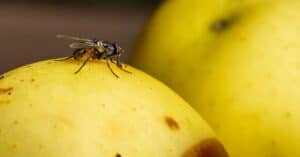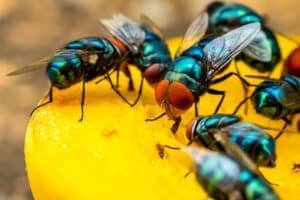What is a True Fly?
True flies come in a variety of shapes and sizes, the majority being under an inch and a half in length, but some can be up to four centimeters long. They possess only one pair of wings, the second pair having morphed into balancing organs that look like clubs. Most have large eyes for navigation when in flight and may resemble wasps or bees. Larvae appear as segmented worms without jointed legs, while pupae are encased within tough skin that may look like a brown capsule. Adult true flies feed on liquid and have either thin sucking or sponging mouthparts.
How Many Are There?
As one of the most diverse groups of insects, flies have a wide range of characteristics and behaviors. With over 150,000 species known from around the world, scientists continue to discover new species regularly. However, it is estimated that there are still many undiscovered species left to be found.
In Michigan’s Great Lakes region alone, there are believed to be over 2,000 different fly species. These flies vary greatly in appearance and behavior – some are attracted to decaying organic matter, while others prefer fresh blood meals from animals or humans.
While not all fly species pose a threat to humans, there are certainly some that will bite and potentially transmit diseases such as West Nile virus or Lyme disease. It’s important for residents and visitors alike to take precautions when spending time outdoors during peak fly season. Wearing protective clothing and using insect repellent can help reduce the risk of bites and potential illness associated with certain types of flies.

In Michigan’s Great Lakes region alone, there are believed to be over 2,000 different fly species.
©melissamn/Shutterstock.com
Biting Flies
Flies are an incredibly diverse group of insects, with over 150,000 species known to science. While the vast majority of flies do not bite humans or other animals, there are a few types that have evolved specialized mouthparts for piercing skin and sucking blood. These “biting flies” include horseflies, deer flies, and black flies.
So why do these particular flies bite humans? The answer lies in their biology and behavior. Biting flies require blood meals to reproduce. Specifically, female biting flies need protein from blood to produce eggs. In most cases, biting fly larvae develop in aquatic environments such as streams or ponds. Once they mature into adults and emerge from the water, they seek out hosts for their next meal.
Biting fly behavior is often characterized by their attraction to movement or carbon dioxide. They may also be drawn to dark colors or certain odors emitted by human sweat or breath. When a biting fly lands on its host’s skin, it uses its sharp mouthparts (known as mandibles) to cut through the skin and reach a blood vessel below.
Unfortunately for us humans, many biting fly bites can be painful and lead to itching or swelling at the site of the bite. Some people may even experience allergic reactions or infections from repeated bites.
While it can be frustrating dealing with these pesky insects during outdoor activities like hiking or camping in Michigan (especially during peak summer months), there are ways we can protect ourselves from being bitten by using insect repellent containing DEET.

When a biting fly lands on its host’s skin, it uses its sharp mouthparts to cut through the skin and reach a blood vessel below.
©iStock.com/ViniSouza128
Deer Flies
Deer flies are a type of biting fly that can be found in Michigan and other regions throughout North America. These pesky insects are known for their painful bites, which can leave itchy welts on the skin.
People in the United States are vulnerable to acquiring Tularemia, also known as “rabbit fever,” from contact with objects or animals, from tick bites, and in some cases, from the bites of the Michigan deer fly, Chrysops discalis.
It is important to take precautions such as wearing long sleeves and pants, using insect repellent, and avoiding areas where these flies are known to be most active.
Deer flies tend to be most active during the summer months when temperatures are warmest. They prefer sunny areas with open fields or wooded edges where they can feed on mammals like deer or cattle.
Overall, while deer flies may be an annoyance for those spending time outdoors in Michigan or other parts of North America during the summer months, taking simple preventative measures can help mitigate their impact.
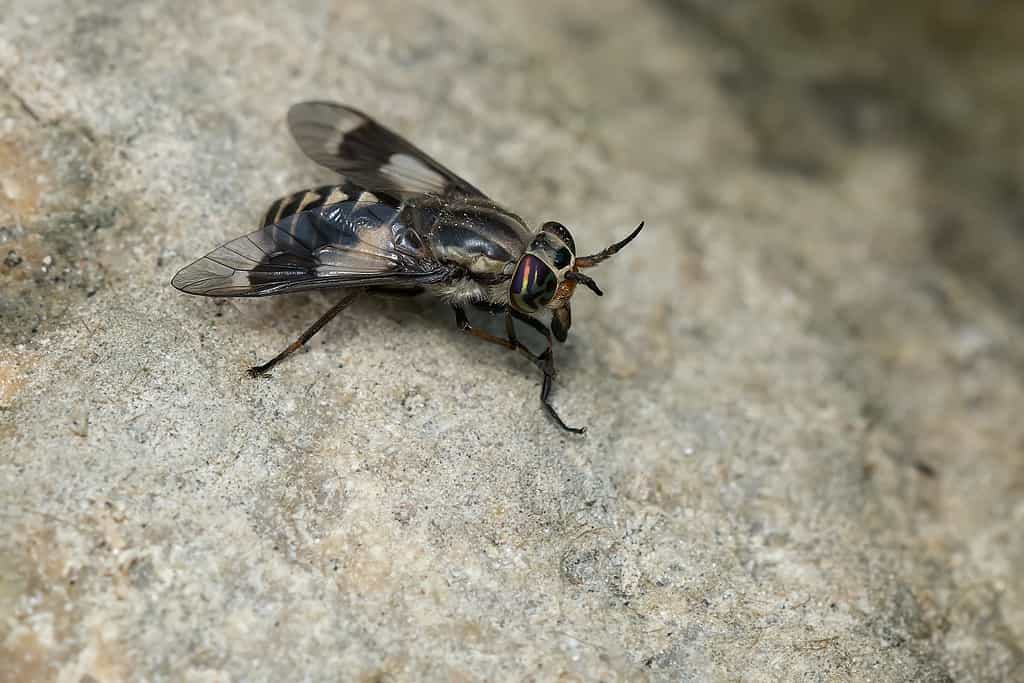
Deer flies are a type of biting fly that can be found in Michigan especially during the summer months.
©Paul Reeves Photography/Shutterstock.com
Horse Flies
Horse flies, also known as deer flies or gadflies, are a type of biting fly found in Michigan and other parts of the world. These insects can be easily distinguished from other types of flies by their large size and distinct coloring. They typically measure about 1-2 inches long with dark brown or black bodies that have bold markings in shades of green, yellow, or blue.
One important characteristic to note is that female horse flies require blood meals for egg production, while males feed on nectar and pollen. Unfortunately, these blood meals often come at the expense of humans and livestock alike. Horse flies are notorious biters that inflict painful, itchy wounds when they land on their prey’s skin.
In addition to their unpleasant bites, horse flies have been known to transmit diseases such as Tularemia to both animals and humans through their feeding activities. Tularemia is a bacterial infection that can cause fever-like symptoms, including chills, headaches, body aches, fatigue, and swollen lymph nodes.
Horse flies tend to be most active during the summer months when temperatures are warmest. They prefer habitats near water sources like lakes or rivers, where they lay eggs on aquatic vegetation before hatching into larvae which then develop underwater until adulthood.
Overall, encountering horse flies can present a challenge for anyone spending time outdoors in Michigan during peak season but taking precautions such as wearing protective clothing or using insect repellent may help reduce exposure to these pesky pests.
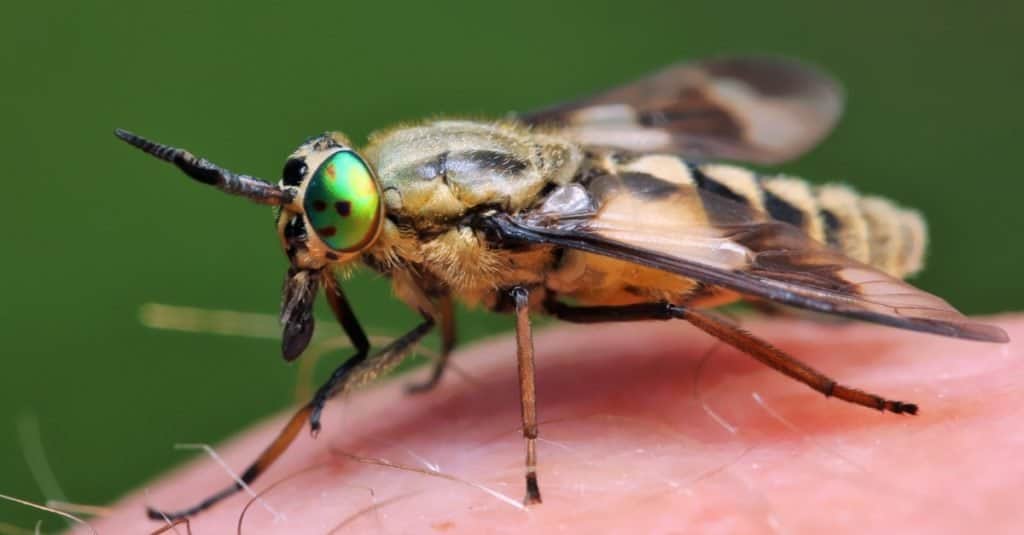
Female horse flies require blood meals for egg production, which often comes at the expense of humans and livestock alike.
©Achkin/Shutterstock.com
Stable Flies
Stable flies are a type of biting fly that can cause significant discomfort for humans and animals alike. They are typically about the size of a housefly, with distinctive dark stripes on their abdomen and piercing mouthparts used to obtain blood meals. While these pests may resemble other types of flies at first glance, their preference for biting mammals sets them apart from other common species.
In addition to causing itchy welts on human skin, stable flies can also be carriers of diseases that affect both animals and people. These include diseases such as equine infectious anemia and Tularemia, which can have serious health consequences if left untreated.
Stable flies tend to be most active during the warmer months in Michigan when temperatures reach above 70 degrees Fahrenheit. This is because they require warm conditions in order to complete their life cycle, which involves laying eggs in decaying organic matter such as hay or manure.
As far as habitat goes, stable flies prefer areas where livestock or wildlife congregate – such as farms or wooded areas – but they can also be found near residential properties with standing water sources like bird baths or stagnant pools. It’s important to take preventative measures against infestations by regularly cleaning up any potential breeding sites and using insecticides if necessary.
Overall, while stable flies may not be the most well-known pest in Michigan’s ecosystem, they are certainly one worth paying attention to for anyone who spends time outdoors during the summer months.

The stable fly is about the size of a housefly, with distinctive dark stripes on their abdomen.
©Vinicius R. Souza/Shutterstock.com
Black Flies
Black flies, also known as buffalo gnats or turkey gnats, are small biting insects found in Michigan and other parts of the world. These tiny pests are most commonly recognized by their dark coloration, which varies from black to brownish-red. They have a distinctive humpbacked appearance with short legs and broad wings that overlap when they’re at rest.
Many people wonder if black flies carry blood-borne zoonotic diseases such as West Nile virus or Lyme disease. While these pesky insects can certainly transmit pathogens from one host to another, there is currently no evidence to suggest that they pose a significant risk to human health in Michigan.
Black flies tend to be most active during the late spring and early summer months when temperatures are warm, and humidity levels are high. During this time, they may swarm around humans and animals alike in search of a blood meal. In fact, some species of black fly females require a protein-rich diet before laying eggs.
In terms of habitat preferences, black flies tend to breed near running water sources such as streams or rivers, where larvae develop on rocks or submerged vegetation. As adults, they typically remain close to water sources but may travel up to several miles in search of hosts for feeding.
Overall, while these tiny biting insects can certainly be annoying for those living or visiting Michigan during their active season (late spring/early summer), taking appropriate precautions such as wearing protective clothing and using insect repellents can help reduce your risk of being bitten by them!
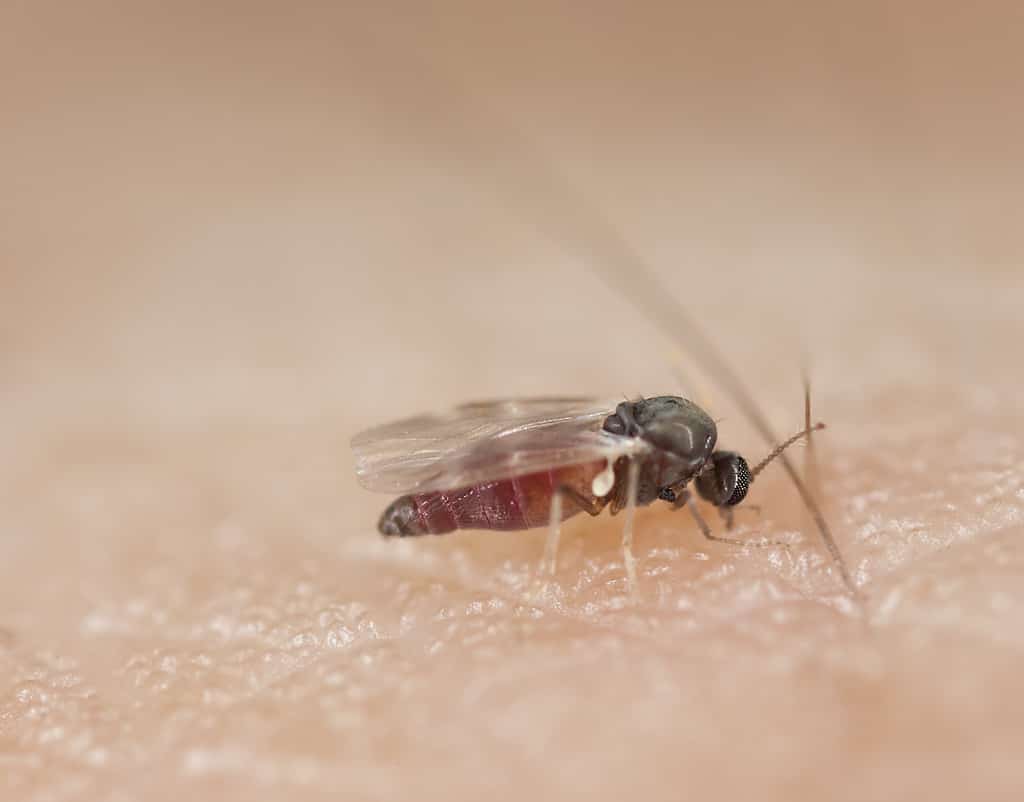
Black flies are small biting insects found in Michigan which are known to swarm around humans and animals alike in search of a blood meal.
©iStock.com/Henrik_L
Biting Midges
Biting midges, also known as Ceratopogonidae, are small flies that can be found in Michigan. Despite their small size, they pack a powerful and painful bite that can leave humans and animals alike itching for days. These insects typically measure less than 1/8 inch in length and have a hunched appearance with short legs.
While biting midges are not known to transmit blood-borne zoonotic diseases such as the West Nile virus or Zika virus, they can still pose a threat to both human and animal health due to the potential for secondary infections from scratching at the site of the bites. Additionally, some species of biting midges may carry other pathogens or parasites that could potentially cause illness.
Biting midges tend to be most active during dawn and dusk hours when temperatures are cooler and humidity is higher. They prefer wet environments such as marshes, swamps, ponds, lakeshores, riverbanks, or even just areas with standing water like bird baths or puddles.
It’s important to take precautions against biting midge bites if you plan on spending time outdoors during peak activity times or within their preferred habitats. This includes wearing long sleeves/pants and using insect repellents containing DEET or picaridin, which are effective against these pests.
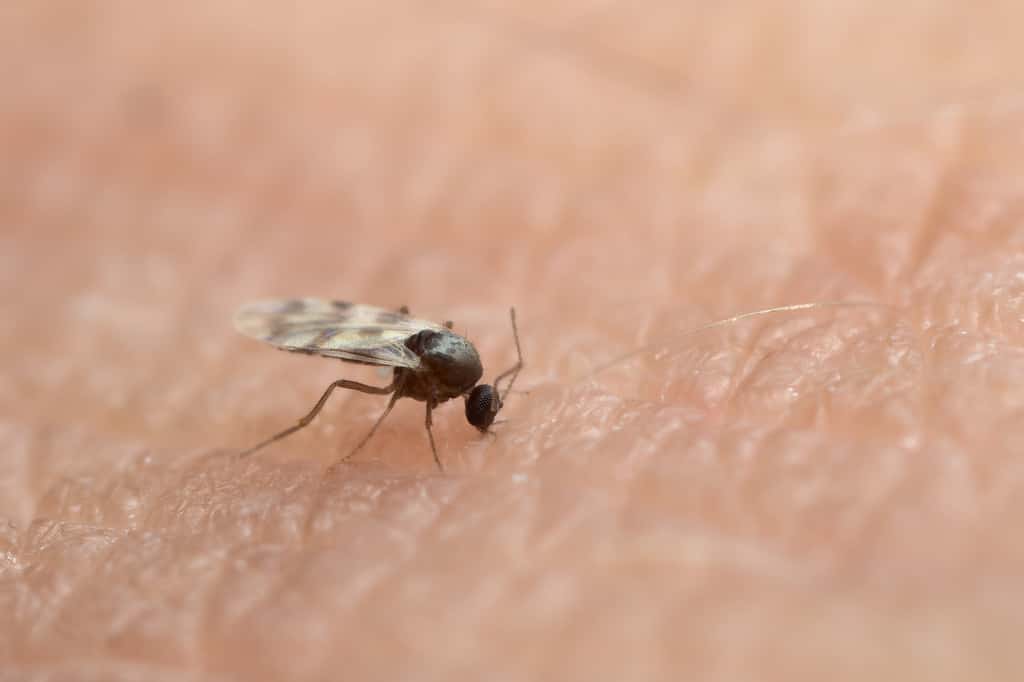
Midges pack a powerful and painful bite that can leave humans and animals alike itching for days.
©Henrik Larsson/Shutterstock.com
The photo featured at the top of this post is © Vinicius R. Souza/Shutterstock.com
Thank you for reading! Have some feedback for us? Contact the AZ Animals editorial team.



